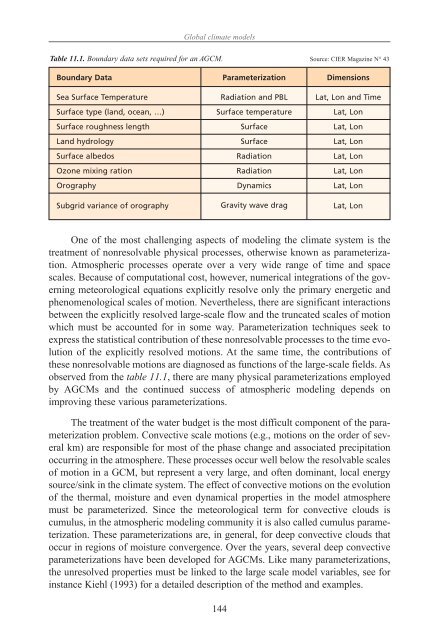chapter - Atmospheric and Oceanic Science
chapter - Atmospheric and Oceanic Science
chapter - Atmospheric and Oceanic Science
Create successful ePaper yourself
Turn your PDF publications into a flip-book with our unique Google optimized e-Paper software.
Global climate models<br />
Table 11.1. Boundary data sets required for an AGCM. Source: CIER Magazine N° 43<br />
Boundary Data Parameterization Dimensions<br />
Sea Surface Temperature Radiation <strong>and</strong> PBL Lat, Lon <strong>and</strong> Time<br />
Surface type (l<strong>and</strong>, ocean, …) Surface temperature Lat, Lon<br />
Surface roughness length Surface Lat, Lon<br />
L<strong>and</strong> hydrology Surface Lat, Lon<br />
Surface albedos Radiation Lat, Lon<br />
Ozone mixing ration Radiation Lat, Lon<br />
Orography Dynamics Lat, Lon<br />
Subgrid variance of orography Gravity wave drag Lat, Lon<br />
One of the most challenging aspects of modeling the climate system is the<br />
treatment of nonresolvable physical processes, otherwise known as parameterization.<br />
<strong>Atmospheric</strong> processes operate over a very wide range of time <strong>and</strong> space<br />
scales. Because of computational cost, however, numerical integrations of the governing<br />
meteorological equations explicitly resolve only the primary energetic <strong>and</strong><br />
phenomenological scales of motion. Nevertheless, there are significant interactions<br />
between the explicitly resolved large-scale flow <strong>and</strong> the truncated scales of motion<br />
which must be accounted for in some way. Parameterization techniques seek to<br />
express the statistical contribution of these nonresolvable processes to the time evolution<br />
of the explicitly resolved motions. At the same time, the contributions of<br />
these nonresolvable motions are diagnosed as functions of the large-scale fields. As<br />
observed from the table 11.1, there are many physical parameterizations employed<br />
by AGCMs <strong>and</strong> the continued success of atmospheric modeling depends on<br />
improving these various parameterizations.<br />
The treatment of the water budget is the most difficult component of the parameterization<br />
problem. Convective scale motions (e.g., motions on the order of several<br />
km) are responsible for most of the phase change <strong>and</strong> associated precipitation<br />
occurring in the atmosphere. These processes occur well below the resolvable scales<br />
of motion in a GCM, but represent a very large, <strong>and</strong> often dominant, local energy<br />
source/sink in the climate system. The effect of convective motions on the evolution<br />
of the thermal, moisture <strong>and</strong> even dynamical properties in the model atmosphere<br />
must be parameterized. Since the meteorological term for convective clouds is<br />
cumulus, in the atmospheric modeling community it is also called cumulus parameterization.<br />
These parameterizations are, in general, for deep convective clouds that<br />
occur in regions of moisture convergence. Over the years, several deep convective<br />
parameterizations have been developed for AGCMs. Like many parameterizations,<br />
the unresolved properties must be linked to the large scale model variables, see for<br />
instance Kiehl (1993) for a detailed description of the method <strong>and</strong> examples.<br />
144






